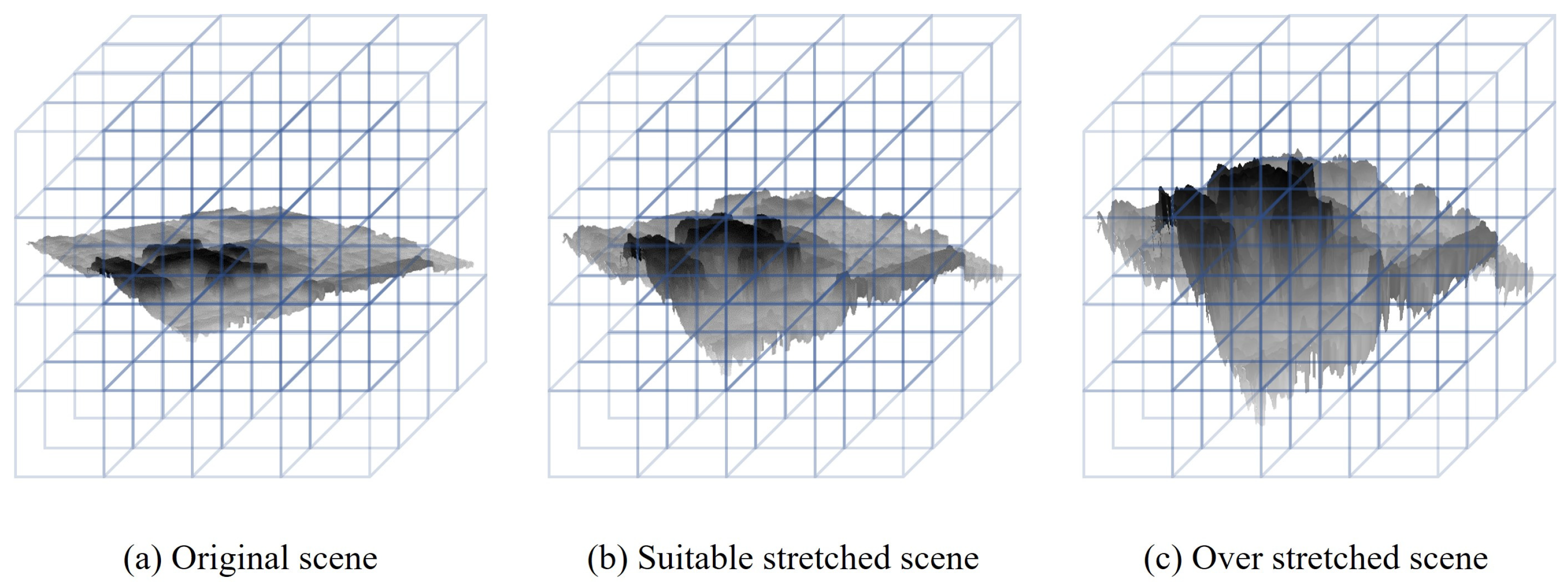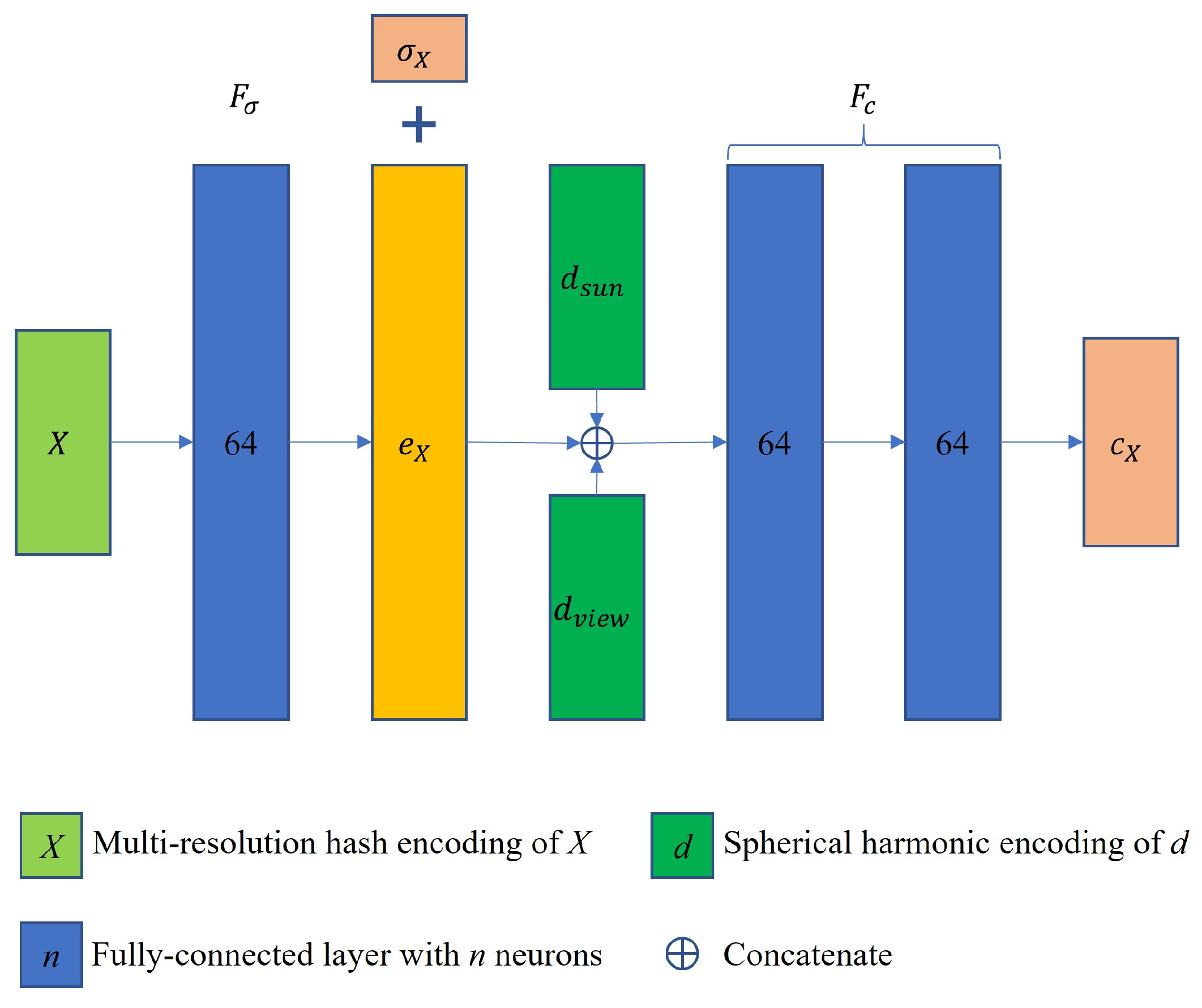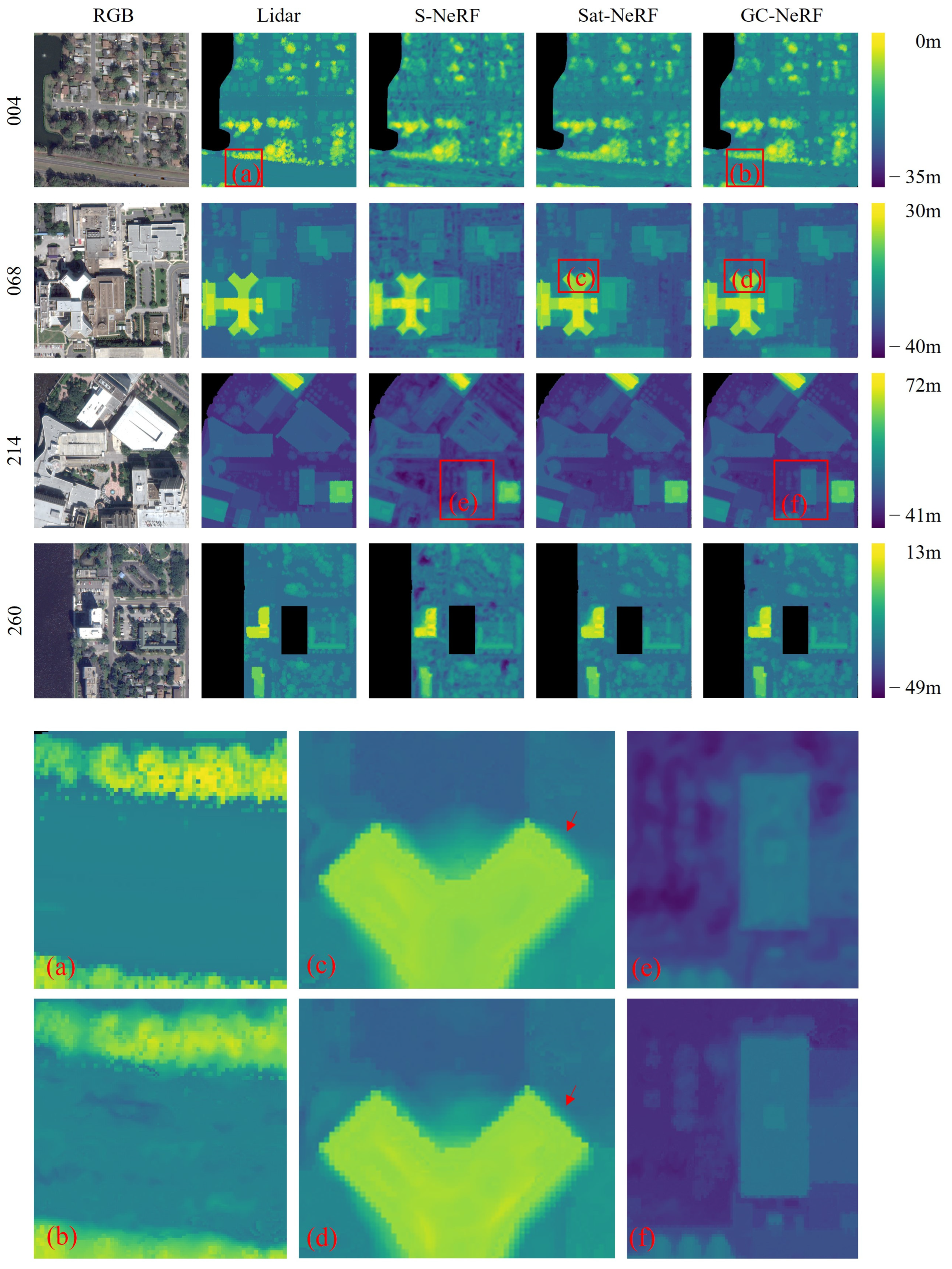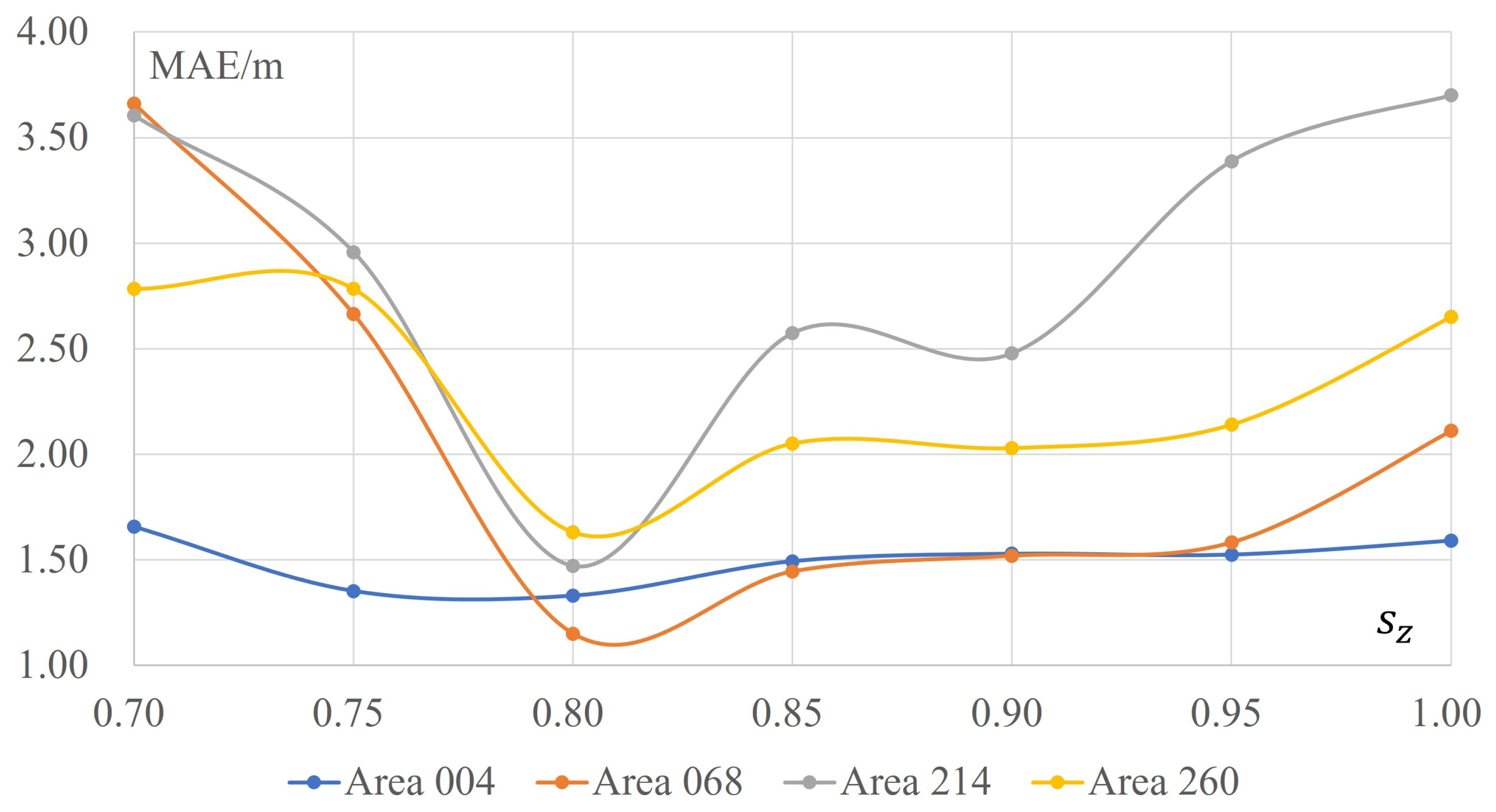Constraining the Geometry of NeRFs for Accurate DSM Generation from Multi-View Satellite Images
Abstract
1. Introduction
2. Related Work
2.1. Multi-View Stereo for Satellite Images
2.2. Neural Radiance Field
2.3. NeRF Variants for Multi-View Satellite Photogrammetry
3. Methods
3.1. Z-axis Stretched Radiance Model
3.2. Occupancy Grid Converted from Sparse Point Cloud
3.3. Geometric Loss Term
3.4. Multi-View DSMs Fusion
4. Experiments and Results
4.1. Implementation Details
4.2. Result Analysis
4.3. Ablation Analysis
5. Discussion
6. Conclusions
Author Contributions
Funding
Data Availability Statement
Acknowledgments
Conflicts of Interest
References
- Peter, B.G.; Messina, J.P.; Carroll, J.W.; Zhi, J.; Chimonyo, V.; Lin, S.; Snapp, S.S. Multi-Spatial Resolution Satellite and sUAS Imagery for Precision Agriculture on Smallholder Farms in Malawi. Photogramm. Eng. Remote Sens. 2020, 86, 107–119. [Google Scholar] [CrossRef]
- Barrile, V.; Simonetti, S.; Citroni, R.; Fotia, A.; Bilotta, G. Experimenting Agriculture 4.0 with Sensors: A Data Fusion Approach between Remote Sensing, UAVs and Self-Driving Tractors. Sensors 2022, 22, 7910. [Google Scholar] [CrossRef]
- Pearse, G.D.; Dash, J.P.; Persson, H.J.; Watt, M.S. Comparison of High-Density LiDAR and Satellite Photogrammetry for Forest Inventory. ISPRS J. Photogramm. Remote Sens. 2018, 142, 257–267. [Google Scholar] [CrossRef]
- Njimi, H.; Chehata, N.; Revers, F. Fusion of Dense Airborne LiDAR and Multispectral Sentinel-2 and Pleiades Satellite Imagery for Mapping Riparian Forest Species Biodiversity at Tree Level. Sensors 2024, 24, 1753. [Google Scholar] [CrossRef]
- Jaud, M.; Geoffroy, L.; Chauvet, F.; Durand, E.; Civet, F. Potential of a Virtual Reality Environment Based on Very-High-Resolution Satellite Imagery for Structural Geology Measurements of Lava Flows. J. Struct. Geol. 2022, 158, 104569. [Google Scholar] [CrossRef]
- Demarez, V.; Helen, F.; Marais-Sicre, C.; Baup, F. In-Season Mapping of Irrigated Crops Using Landsat 8 and Sentinel-1 Time Series. Remote Sens. 2019, 11, 118. [Google Scholar] [CrossRef]
- Bhattacharya, S.; Braun, C.; Leopold, U. An Efficient 2.5D Shadow Detection Algorithm for Urban Planning and Design Using a Tensor Based Approach. ISPRS Int. J. Geo-Inf. 2021, 10, 583. [Google Scholar] [CrossRef]
- Chen, C.; Ye, S.; Bai, Z.; Wang, J.; Nedzved, A.; Ablameyko, S. Intelligent Mining of Urban Ventilated Corridor Based on Digital Surface Model under the Guidance of K-Means. ISPRS Int. J. Geo-Inf. 2022, 11, 216. [Google Scholar] [CrossRef]
- Zhang, J.; Xu, W.; Qin, L.; Tian, Y. Spatial Distribution Estimates of the Urban Population Using DSM and DEM Data in China. ISPRS Int. J. Geo-Inf. 2018, 7, 435. [Google Scholar] [CrossRef]
- Zhu, L.; Shen, S.; Gao, X.; Hu, Z. Urban Scene Vectorized Modeling Based on Contour Deformation. ISPRS Int. J. Geo-Inf. 2020, 9, 162. [Google Scholar] [CrossRef]
- McClean, F.; Dawson, R.; Kilsby, C. Implications of Using Global Digital Elevation Models for Flood Risk Analysis in Cities. Water Resour. Res. 2020, 56, e2020WR028241. [Google Scholar] [CrossRef]
- Qin, R.; Tian, J.; Reinartz, P. 3D Change Detection—Approaches and Applications. ISPRS J. Photogramm. Remote Sens. 2016, 122, 41–56. [Google Scholar] [CrossRef]
- Zhang, L.; Yang, L.; Zohner, C.M.; Crowther, T.W.; Li, M.; Shen, F.; Guo, M.; Qin, J.; Yao, L.; Zhou, C. Direct and Indirect Impacts of Urbanization on Vegetation Growth across the World’s Cities. Sci. Adv. 2022, 8, eabo0095. [Google Scholar] [CrossRef] [PubMed]
- Gómez, A.; Randall, G.; Facciolo, G.; von Gioi, R.G. An Experimental Comparison of Multi-View Stereo Approaches on Satellite Images. In Proceedings of the IEEE/CVF Winter Conference on Applications of Computer Vision, Waikoloa, HI, USA, 3–8 January 2022; pp. 844–853. [Google Scholar]
- de Franchis, C.; Meinhardt-Llopis, E.; Michel, J.; Morel, J.-M.; Facciolo, G. An Automatic and Modular Stereo Pipeline for Pushbroom Images. ISPRS Ann. Photogramm. Remote Sens. Spat. Inf. Sci. 2014, II–3, 49–56. [Google Scholar] [CrossRef]
- d’Angelo, P.; Kuschk, G. Dense Multi-View Stereo from Satellite Imagery. In Proceedings of the 2012 IEEE International Geoscience and Remote Sensing Symposium, Munich, Germany, 22–27 July 2012; pp. 6944–6947. [Google Scholar]
- Gong, K.; Fritsch, D. DSM Generation from High Resolution Multi-View Stereo Satellite Imagery. Photogramm. Eng. Remote Sens. 2019, 85, 379–387. [Google Scholar] [CrossRef]
- Facciolo, G.; de Franchis, C.; Meinhardt-Llopis, E. Automatic 3D Reconstruction from Multi-Date Satellite Images. In Proceedings of the IEEE Conference on Computer Vision and Pattern Recognition Workshops (CVPRW), Honolulu, HI, USA, 21–26 July 2017; pp. 57–66. [Google Scholar]
- Mildenhall, B.; Srinivasan, P.P.; Tancik, M.; Barron, J.T.; Ramamoorthi, R. NeRF: Representing Scenes as Neural Radiance Fields for View Synthesis. In Computer Vision—ECCV 2020; Springer International Publishing: Cham, Switzerland, 2020; pp. 405–421. [Google Scholar]
- Marí, R.; Facciolo, G.; Ehret, T. Sat-NeRF: Learning Multi-View Satellite Photogrammetry with Transient Objects and Shadow Modeling Using RPC Cameras. In Proceedings of the IEEE/CVF Conference on Computer Vision and Pattern Recognition Workshops (CVPRW), New Orleans, LA, USA, 19–20 June 2022; pp. 1311–1321. [Google Scholar]
- Marí, R.; Facciolo, G.; Ehret, T. Multi-Date Earth Observation NeRF: The Detail Is in the Shadows. In Proceedings of the IEEE/CVF Conference on Computer Vision and Pattern Recognition Workshops (CVPRW), Vancouver, BC, Canada, 17–24 June 2023; pp. 2034–2044. [Google Scholar]
- Kajiya, J.T.; Von Herzen, B.P. Ray Tracing Volume Densities. SIGGRAPH Comput. Graph. 1984, 18, 165–174. [Google Scholar] [CrossRef]
- Derksen, D.; Izzo, D. Shadow Neural Radiance Fields for Multi-View Satellite Photogrammetry. In Proceedings of the 2021 IEEE/CVF Conference on Computer Vision and Pattern Recognition Workshops (CVPRW), Nashville, TN, USA, 19–25 June 2021; pp. 1152–1161. [Google Scholar]
- Müller, T.; Evans, A.; Schied, C.; Keller, A. Instant Neural Graphics Primitives with a Multiresolution Hash Encoding. ACM Trans. Graph. 2022, 41, 1–15. [Google Scholar] [CrossRef]
- Srinivasan, P.P.; Deng, B.; Zhang, X.; Tancik, M.; Mildenhall, B.; Barron, J.T. NeRV: Neural Reflectance and Visibility Fields for Relighting and View Synthesis. In Proceedings of the IEEE/CVF Conference on Computer Vision and Pattern Recognition (CVPR), Nashville, TN, USA, 20–25 June 2021; pp. 7495–7504. [Google Scholar]
- Schönberger, J.L.; Zheng, E.; Frahm, J.-M.; Pollefeys, M. Pixelwise View Selection for Unstructured Multi-View Stereo. In Computer Vision—ECCV 2016; Leibe, B., Matas, J., Sebe, N., Welling, M., Eds.; Springer International Publishing: Cham, Switzerland, 2016; pp. 501–518. [Google Scholar]
- Krauß, T.; d’Angelo, P.; Schneider, M.; Gstaiger, V. THE FULLY AUTOMATIC OPTICAL PROCESSING SYSTEM CATENA AT DLR. Int. Arch. Photogramm. Remote Sens. Spat. Inf. Sci. 2013, XL-1-W1, 177–183. [Google Scholar] [CrossRef]
- Qu, Y.; Deng, F. Sat-Mesh: Learning Neural Implicit Surfaces for Multi-View Satellite Reconstruction. Remote Sens. 2023, 15, 4297. [Google Scholar] [CrossRef]
- Beyer, R.A.; Alexandrov, O.; McMichael, S. The Ames Stereo Pipeline: NASA’s Open Source Software for Deriving and Processing Terrain Data. Earth Space Sci. 2018, 5, 537–548. [Google Scholar] [CrossRef]
- Facciolo, G.; Franchis, C.D.; Meinhardt, E. MGM: A Significantly More Global Matching for Stereovision. In Proceedings of the British Machine Vision Conference (BMVC), Swansea, UK, 7–10 September 2015. [Google Scholar]
- Rothermel, M.; Wenzel, K.; Fritsch, D.; Haala, N. SURE: Photogrammetric Surface Reconstruction from Imagery. In Proceedings of the LC3D Workshop, Berlin, Germany, 4–5 December 2012; Volume 8. [Google Scholar]
- Lastilla, L.; Ravanelli, R.; Fratarcangeli, F.; Di Rita, M.; Nascetti, A.; Crespi, M. FOSS4G DATE FOR DSM GENERATION: SENSITIVITY ANALYSIS OF THE SEMI-GLOBAL BLOCK MATCHING PARAMETERS. Int. Arch. Photogramm. Remote Sens. Spat. Inf. Sci. 2019, XLII-2-W13, 67–72. [Google Scholar] [CrossRef]
- Han, Y.; Wang, S.; Gong, D.; Wang, Y.; Ma, X. STATE OF THE ART IN DIGITAL SURFACE MODELLING FROM MULTI-VIEW HIGH-RESOLUTION SATELLITE IMAGES. ISPRS Ann. Photogramm. Remote Sens. Spat. Inf. Sci. 2020, V-2–2020, 351–356. [Google Scholar] [CrossRef]
- Zhang, F.; Prisacariu, V.; Yang, R.; Torr, P.H.S. GA-Net: Guided Aggregation Net for End-To-End Stereo Matching. In Proceedings of the IEEE/CVF Conference on Computer Vision and Pattern Recognition (CVPR), Long Beach, CA, USA, 15–20 June 2019; pp. 185–194. [Google Scholar]
- Chang, J.-R.; Chen, Y.-S. Pyramid Stereo Matching Network. In Proceedings of the IEEE Conference on Computer Vision and Pattern Recognition, Salt Lake City, UT, USA, 18–23 June 2018; pp. 5410–5418. [Google Scholar]
- Yang, G.; Manela, J.; Happold, M.; Ramanan, D. Hierarchical Deep Stereo Matching on High-Resolution Images. In Proceedings of the IEEE/CVF Conference on Computer Vision and Pattern Recognition (CVPR), Long Beach, CA, USA, 15–20 June 2019; pp. 5515–5524. [Google Scholar]
- Marí, R.; Ehret, T.; Facciolo, G. Disparity Estimation Networks for Aerial and High-Resolution Satellite Images: A Review. Image Process. Line 2022, 12, 501–526. [Google Scholar] [CrossRef]
- Xiangli, Y.; Xu, L.; Pan, X.; Zhao, N.; Rao, A.; Theobalt, C.; Dai, B.; Lin, D. BungeeNeRF: Progressive Neural Radiance Field for Extreme Multi-Scale Scene Rendering. In Computer Vision—ECCV 2022; Avidan, S., Brostow, G., Cissé, M., Farinella, G.M., Hassner, T., Eds.; Springer Nature Switzerland: Cham, Switzerland, 2022; pp. 106–122. [Google Scholar]
- Tancik, M.; Casser, V.; Yan, X.; Pradhan, S.; Mildenhall, B.; Srinivasan, P.P.; Barron, J.T.; Kretzschmar, H. Block-NeRF: Scalable Large Scene Neural View Synthesis. In Proceedings of the IEEE/CVF Conference on Computer Vision and Pattern Recognition, New Orleans, LA, USA, 18–24 June 2022; pp. 8248–8258. [Google Scholar]
- Moreau, A.; Piasco, N.; Tsishkou, D.; Stanciulescu, B.; de La Fortelle, A. LENS: Localization Enhanced by NeRF Synthesis. In Proceedings of the 5th Conference on Robot Learning, London, UK, 11 January 2022; pp. 1347–1356. [Google Scholar]
- Turki, H.; Ramanan, D.; Satyanarayanan, M. Mega-NeRF: Scalable Construction of Large-Scale NeRFs for Virtual Fly-Throughs. In Proceedings of the IEEE/CVF Conference on Computer Vision and Pattern Recognition (CVPR), New Orleans, LA, USA, 18–24 June 2022; pp. 12922–12931. [Google Scholar]
- Chen, A.; Xu, Z.; Zhao, F.; Zhang, X.; Xiang, F.; Yu, J.; Su, H. MVSNeRF: Fast Generalizable Radiance Field Reconstruction from Multi-View Stereo. In Proceedings of the IEEE/CVF International Conference on Computer Vision, Montreal, QC, Canada, 10–17 October 2021; pp. 14124–14133. [Google Scholar]
- Boss, M.; Braun, R.; Jampani, V.; Barron, J.T.; Liu, C.; Lensch, H.P.A. NeRD: Neural Reflectance Decomposition from Image Collections. In Proceedings of the IEEE/CVF International Conference on Computer Vision, Montreal, QC, Canada, 10–17 October 2021; pp. 12684–12694. [Google Scholar]
- Guo, Y.-C.; Kang, D.; Bao, L.; He, Y.; Zhang, S.-H. NeRFReN: Neural Radiance Fields with Reflections. In Proceedings of the IEEE/CVF Conference on Computer Vision and Pattern Recognition (CVPR), New Orleans, LA, USA, 18–24 June 2022; pp. 18409–18418. [Google Scholar]
- Verbin, D.; Hedman, P.; Mildenhall, B.; Zickler, T.; Barron, J.T.; Srinivasan, P.P. Ref-NeRF: Structured View-Dependent Appearance for Neural Radiance Fields. In Proceedings of the 2022 IEEE/CVF Conference on Computer Vision and Pattern Recognition (CVPR), New Orleans, LA, USA, 18–24 June 2022; pp. 5481–5490. [Google Scholar]
- Mildenhall, B.; Hedman, P.; Martin-Brualla, R.; Srinivasan, P.P.; Barron, J.T. NeRF in the Dark: High Dynamic Range View Synthesis from Noisy Raw Images. In Proceedings of the IEEE/CVF Conference on Computer Vision and Pattern Recognition (CVPR), New Orleans, LA, USA, 18–24 June 2022; pp. 16190–16199. [Google Scholar]
- Pumarola, A.; Corona, E.; Pons-Moll, G.; Moreno-Noguer, F. D-NeRF: Neural Radiance Fields for Dynamic Scenes. In Proceedings of the 2021 IEEE/CVF Conference on Computer Vision and Pattern Recognition (CVPR), Nashville, TN, USA, 20–25 June 2021; pp. 10313–10322. [Google Scholar]
- Fang, J.; Yi, T.; Wang, X.; Xie, L.; Zhang, X.; Liu, W.; Nießner, M.; Tian, Q. Fast Dynamic Radiance Fields with Time-Aware Neural Voxels. In SIGGRAPH Asia 2022 Conference Papers; Association for Computing Machinery: New York, NY, USA, 2022; pp. 1–9. [Google Scholar]
- Attal, B.; Laidlaw, E.; Gokaslan, A.; Kim, C.; Richardt, C.; Tompkin, J.; O’ Toole, M. TöRF: Time-of-Flight Radiance Fields for Dynamic Scene View Synthesis. In Advances in Neural Information Processing Systems; Curran Associates, Inc.: Red Hook, NY, USA, 2021; Volume 34, pp. 26289–26301. [Google Scholar]
- Liu, J.-W.; Cao, Y.-P.; Mao, W.; Zhang, W.; Zhang, D.J.; Keppo, J.; Shan, Y.; Qie, X.; Shou, M.Z. DeVRF: Fast Deformable Voxel Radiance Fields for Dynamic Scenes. Adv. Neural Inf. Process. Syst. 2022, 35, 36762–36775. [Google Scholar]
- Athar, S.; Shu, Z.; Samaras, D. FLAME-in-NeRF: Neural Control of Radiance Fields for Free View Face Animation. In Proceedings of the 2023 IEEE 17th International Conference on Automatic Face and Gesture Recognition (FG), Waikoloa Beach, HI, USA, 5–8 January 2023; pp. 1–8. [Google Scholar]
- Barron, J.T.; Mildenhall, B.; Tancik, M.; Hedman, P.; Martin-Brualla, R.; Srinivasan, P.P. Mip-NeRF: A Multiscale Representation for Anti-Aliasing Neural Radiance Fields. In Proceedings of the 2021 IEEE/CVF International Conference on Computer Vision (ICCV), Montreal, QC, Canada, 10–17 October 2021; pp. 5835–5844. [Google Scholar]
- Barron, J.T.; Mildenhall, B.; Verbin, D.; Srinivasan, P.P.; Hedman, P. Mip-NeRF 360: Unbounded Anti-Aliased Neural Radiance Fields. In Proceedings of the IEEE/CVF Conference on Computer Vision and Pattern Recognition (CVPR), New Orleans, LA, USA, 18–24 June 2022; pp. 5470–5479. [Google Scholar]
- Martin-Brualla, R.; Radwan, N.; Sajjadi, M.S.M.; Barron, J.T.; Dosovitskiy, A.; Duckworth, D. NeRF in the Wild: Neural Radiance Fields for Unconstrained Photo Collections. In Proceedings of the 2021 IEEE/CVF Conference on Computer Vision and Pattern Recognition (CVPR), Nashville, TN, USA, 20–25 June 2021; pp. 7206–7215. [Google Scholar]
- Zhang, K.; Snavely, N.; Sun, J. Leveraging Vision Reconstruction Pipelines for Satellite Imagery. In Proceedings of the 2019 IEEE/CVF International Conference on Computer Vision Workshop (ICCVW), Seoul, Republic of Korea, 27–28 October 2019. [Google Scholar]
- Piala, M.; Clark, R. TermiNeRF: Ray Termination Prediction for Efficient Neural Rendering. In Proceedings of the 2021 International Conference on 3D Vision (3DV), London, UK, 1–3 December 2021; pp. 1106–1114. [Google Scholar]
- Neff, T.; Stadlbauer, P.; Parger, M.; Kurz, A.; Mueller, J.H.; Chaitanya, C.R.A.; Kaplanyan, A.; Steinberger, M. DONeRF: Towards Real-Time Rendering of Compact Neural Radiance Fields Using Depth Oracle Networks. Comput. Graph. Forum 2021, 40, 45–59. [Google Scholar] [CrossRef]
- Rebain, D.; Jiang, W.; Yazdani, S.; Li, K.; Yi, K.M.; Tagliasacchi, A. DeRF: Decomposed Radiance Fields. In Proceedings of the 2021 IEEE/CVF Conference on Computer Vision and Pattern Recognition (CVPR), Nashville, TN, USA, 20–25 June 2021; pp. 14148–14156. [Google Scholar]
- Reiser, C.; Peng, S.; Liao, Y.; Geiger, A. KiloNeRF: Speeding up Neural Radiance Fields with Thousands of Tiny MLPs. In Proceedings of the 2021 IEEE/CVF International Conference on Computer Vision (ICCV), Montreal, QC, Canada, 10–17 October 2021; pp. 14315–14325. [Google Scholar]
- Xu, Q.; Xu, Z.; Philip, J.; Bi, S.; Shu, Z.; Sunkavalli, K.; Neumann, U. Point-NeRF: Point-Based Neural Radiance Fields. In Proceedings of the IEEE/CVF Conference on Computer Vision and Pattern Recognition (CVPR), New Orleans, LA, USA, 18–24 June 2022; pp. 5438–5448. [Google Scholar]
- Fridovich-Keil, S.; Yu, A.; Tancik, M.; Chen, Q.; Recht, B.; Kanazawa, A. Plenoxels: Radiance Fields Without Neural Networks. In Proceedings of the IEEE/CVF Conference on Computer Vision and Pattern Recognition (CVPR), New Orleans, LA, USA, 18–24 June 2022; pp. 5501–5510. [Google Scholar]
- Marí, R.; de Franchis, C.; Meinhardt-Llopis, E.; Anger, J.; Facciolo, G. A Generic Bundle Adjustment Methodology for Indirect RPC Model Refinement of Satellite Imagery. Image Process. Line 2021, 11, 344–373. [Google Scholar] [CrossRef]
- Xie, S.; Zhang, L.; Jeon, G.; Yang, X. Remote Sensing Neural Radiance Fields for Multi-View Satellite Photogrammetry. Remote Sens. 2023, 15, 3808. [Google Scholar] [CrossRef]
- Li, C.; Wu, B.; Pumarola, A.; Zhang, P.; Lin, Y.; Vajda, P. INGeo: Accelerating Instant Neural Scene Reconstruction with Noisy Geometry Priors. In Computer Vision—ECCV 2022 Workshops; Karlinsky, L., Michaeli, T., Nishino, K., Eds.; Springer Nature Switzerland: Cham, Switzerland, 2023; pp. 686–694. [Google Scholar]
- Le Saux, B.; Yokoya, N.; Haensch, R.; Brown, M. 2019 IEEE GRSS Data Fusion Contest: Large-Scale Semantic 3D Reconstruction. IEEE Geosci. Remote Sens. Mag. 2019, 7, 33–36. [Google Scholar] [CrossRef]
- Bosch, M.; Foster, K.; Christie, G.; Wang, S.; Hager, G.D.; Brown, M. Semantic Stereo for Incidental Satellite Images. In Proceedings of the 2019 IEEE Winter Conference on Applications of Computer Vision (WACV), Waikoloa, HI, USA, 7–11 January 2019; pp. 1524–1532. [Google Scholar]
- Hu, M.; Luo, X.; Chen, J.; Lee, Y.C.; Zhou, Y.; Wu, D. Virtual Reality: A Survey of Enabling Technologies and Its Applications in IoT. J. Netw. Comput. Appl. 2021, 178, 102970. [Google Scholar] [CrossRef]
- Xia, G.; Bi, Y.; Wang, C. Optimization Design of Passive Residual Heat Removal System Based on Improved Genetic Algorithm. Ann. Nucl. Energy 2023, 189, 109859. [Google Scholar] [CrossRef]
- Zhou, X.; Wang, Y.; Lin, D.; Cao, Z.; Li, B.; Liu, J. SatelliteRF: Accelerating 3D Reconstruction in Multi-View Satellite Images with Efficient Neural Radiance Fields. Appl. Sci. 2024, 14, 2729. [Google Scholar] [CrossRef]
- Niemeyer, M.; Barron, J.T.; Mildenhall, B.; Sajjadi, M.S.M.; Geiger, A.; Radwan, N. RegNeRF: Regularizing Neural Radiance Fields for View Synthesis from Sparse Inputs. In Proceedings of the IEEE/CVF Conference on Computer Vision and Pattern Recognition (CVPR), New Orleans, LA, USA, 18–24 June 2022; pp. 5480–5490. [Google Scholar]
- Chen, X.; Song, Z.; Zhou, J.; Xie, D.; Lu, J. Camera and LiDAR Fusion for Urban Scene Reconstruction and Novel View Synthesis via Voxel-Based Neural Radiance Fields. Remote Sens. 2023, 15, 4628. [Google Scholar] [CrossRef]










| Training Time | Appearance Embedding Module | Complex Irradiance Model | Bounds of Altitude | |
|---|---|---|---|---|
| S-NeRFs [23] | 8 h | no need | yes | need |
| Sat-NeRFs [20] | 10 h | need | yes | need |
| EO-NeRFs [21] | 15 h | need | yes | need |
| GC-NeRFs | 6 min | no need | no | no need |
| Area Index | 004 | 068 | 214 | 260 |
|---|---|---|---|---|
| # train images | 9 | 17 | 22 | 15 |
| # test images | 2 | 2 | 2 | 2 |
| Altitude Bounds [m] | [−24, 0] | [−27, 30] | [−29, 73] | [−30, 13] |
| Type | Rural areas | Urban Areas | Urban Areas | Urban Areas |
| Area Index | 004 | 068 | 214 | 260 | Mean | |||||
|---|---|---|---|---|---|---|---|---|---|---|
| PSNR | MAE | PSNR | MAE | PSNR | MAE | PSNR | MAE | PSNR | MAE | |
| S-NeRFs | 26.1 | 4.42 m | 24.2 | 3.64 m | 24.9 | 4.83 m | 21.5 | 7.71 m | 24.2 | 5.15 m |
| Sat-NeRFs | 26.6 | 1.37 m | 25.0 | 1.28 m | 25.7 | 1.68 m | 21.7 | 1.64 m | 24.7 | 1.49 m |
| SatelliteRFs | 26.6 | - | 25.3 | - | 25.5 | - | 22.0 | - | 24.9 | - |
| GC-NeRFs | 26.8 | 1.33 m | 27.3 | 1.15 m | 26.9 | 1.47 m | 23.6 | 1.63 m | 26.2 | 1.40 m |
| Area Index | 004 | 068 | 214 | 260 |
|---|---|---|---|---|
| GC-NeRFs without scene stretching | 1.59 m | 2.11 m | 3.70 m | 2.65 m |
| GC-NeRFs without geometric constraint | 9.03 m | 10.31 m | 14.19 m | 8.14 m |
| GC-NeRFs without DSM fusion | 1.72 m | 2.01 m | 3.16 m | 2.49 m |
| GC-NeRFs without all the above | 10.21 m | 13.44 m | 16.88 m | 9.47 m |
| GC-NeRFs | 1.33 m | 1.15 m | 1.47 m | 1.63 m |
Disclaimer/Publisher’s Note: The statements, opinions and data contained in all publications are solely those of the individual author(s) and contributor(s) and not of MDPI and/or the editor(s). MDPI and/or the editor(s) disclaim responsibility for any injury to people or property resulting from any ideas, methods, instructions or products referred to in the content. |
© 2024 by the authors. Licensee MDPI, Basel, Switzerland. This article is an open access article distributed under the terms and conditions of the Creative Commons Attribution (CC BY) license (https://creativecommons.org/licenses/by/4.0/).
Share and Cite
Wan, Q.; Guan, Y.; Zhao, Q.; Wen, X.; She, J. Constraining the Geometry of NeRFs for Accurate DSM Generation from Multi-View Satellite Images. ISPRS Int. J. Geo-Inf. 2024, 13, 243. https://doi.org/10.3390/ijgi13070243
Wan Q, Guan Y, Zhao Q, Wen X, She J. Constraining the Geometry of NeRFs for Accurate DSM Generation from Multi-View Satellite Images. ISPRS International Journal of Geo-Information. 2024; 13(7):243. https://doi.org/10.3390/ijgi13070243
Chicago/Turabian StyleWan, Qifeng, Yuzheng Guan, Qiang Zhao, Xiang Wen, and Jiangfeng She. 2024. "Constraining the Geometry of NeRFs for Accurate DSM Generation from Multi-View Satellite Images" ISPRS International Journal of Geo-Information 13, no. 7: 243. https://doi.org/10.3390/ijgi13070243
APA StyleWan, Q., Guan, Y., Zhao, Q., Wen, X., & She, J. (2024). Constraining the Geometry of NeRFs for Accurate DSM Generation from Multi-View Satellite Images. ISPRS International Journal of Geo-Information, 13(7), 243. https://doi.org/10.3390/ijgi13070243







